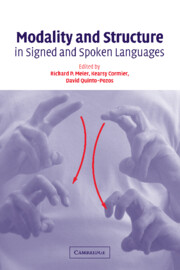Book contents
- Frontmatter
- Contents
- List of figures
- List of tables
- List of contributors
- Acknowledgements
- 1 Why different, why the same? Explaining effects and non-effects of modality upon linguistic structure in sign and speech
- Part I Phonological structure in signed languages
- 2 Modality differences in sign language phonology and morphophonemics
- 3 Beads on a string? Representations of repetition in spoken and signed languages
- 4 Psycholinguistic investigations of phonological structure in ASL
- 5 Modality-dependent aspects of sign language production: Evidence from slips of the hands and their repairs in German Sign Language
- 6 The role of Manually Coded English in language development of deaf children
- Part II Gesture and iconicity in sign and speech
- Part III Syntax in sign: Few or no effects of modality
- Part IV Using space and describing space: Pronouns, classifiers, and verb agreement
- Index
- References
4 - Psycholinguistic investigations of phonological structure in ASL
Published online by Cambridge University Press: 22 September 2009
- Frontmatter
- Contents
- List of figures
- List of tables
- List of contributors
- Acknowledgements
- 1 Why different, why the same? Explaining effects and non-effects of modality upon linguistic structure in sign and speech
- Part I Phonological structure in signed languages
- 2 Modality differences in sign language phonology and morphophonemics
- 3 Beads on a string? Representations of repetition in spoken and signed languages
- 4 Psycholinguistic investigations of phonological structure in ASL
- 5 Modality-dependent aspects of sign language production: Evidence from slips of the hands and their repairs in German Sign Language
- 6 The role of Manually Coded English in language development of deaf children
- Part II Gesture and iconicity in sign and speech
- Part III Syntax in sign: Few or no effects of modality
- Part IV Using space and describing space: Pronouns, classifiers, and verb agreement
- Index
- References
Summary
Introduction
Linguistic categories (e.g. segment, syllable, etc.) have long enabled cogent descriptions of the systematic patterns apparent in spoken languages. Beginning with the seminal work of William Stokoe (1960; 1965), research on the structure of American Sign Language (ASL) has demonstrated that linguistic categories are useful in capturing extant patterns found in a signed language. For example, recognition of a syllable unit permits accounts of morphophonological processes and places constraints on sign forms (Brentari 1990; Perlmutter 1993; Sandler 1993; Corina 1996). Acknowledgment of Movement and Location segments permits descriptions of infixation processes (Liddell and Johnson 1985; Sandler 1986). Feature hierarchies provide accounts of assimilations that are observed in the language and also help to explain those that do not occur (Corina and Sandler 1993). These investigations of linguistic structure have led to a better understanding of both the similarities and differences between signed and spoken language.
Psycholinguists have long sought to understand whether the linguistic categories that are useful for describing patterns in languages are evident in the perception and production of a language. To the extent that behavioral reflexes of these theoretical constructs can be quantified, they are deemed as having a ‘psychological reality’. Psycholinguistic research has been successful in establishing empirical relationships between a subject's behavior and linguistic categories using reaction time and electrophysiological measures.
This chapter describes efforts to use psycholinguistic paradigms to explore the psychological reality of form-based representations in ASL.
Information
- Type
- Chapter
- Information
- Modality and Structure in Signed and Spoken Languages , pp. 88 - 111Publisher: Cambridge University PressPrint publication year: 2002
References
Accessibility standard: Unknown
Why this information is here
This section outlines the accessibility features of this content - including support for screen readers, full keyboard navigation and high-contrast display options. This may not be relevant for you.Accessibility Information
- 23
- Cited by
